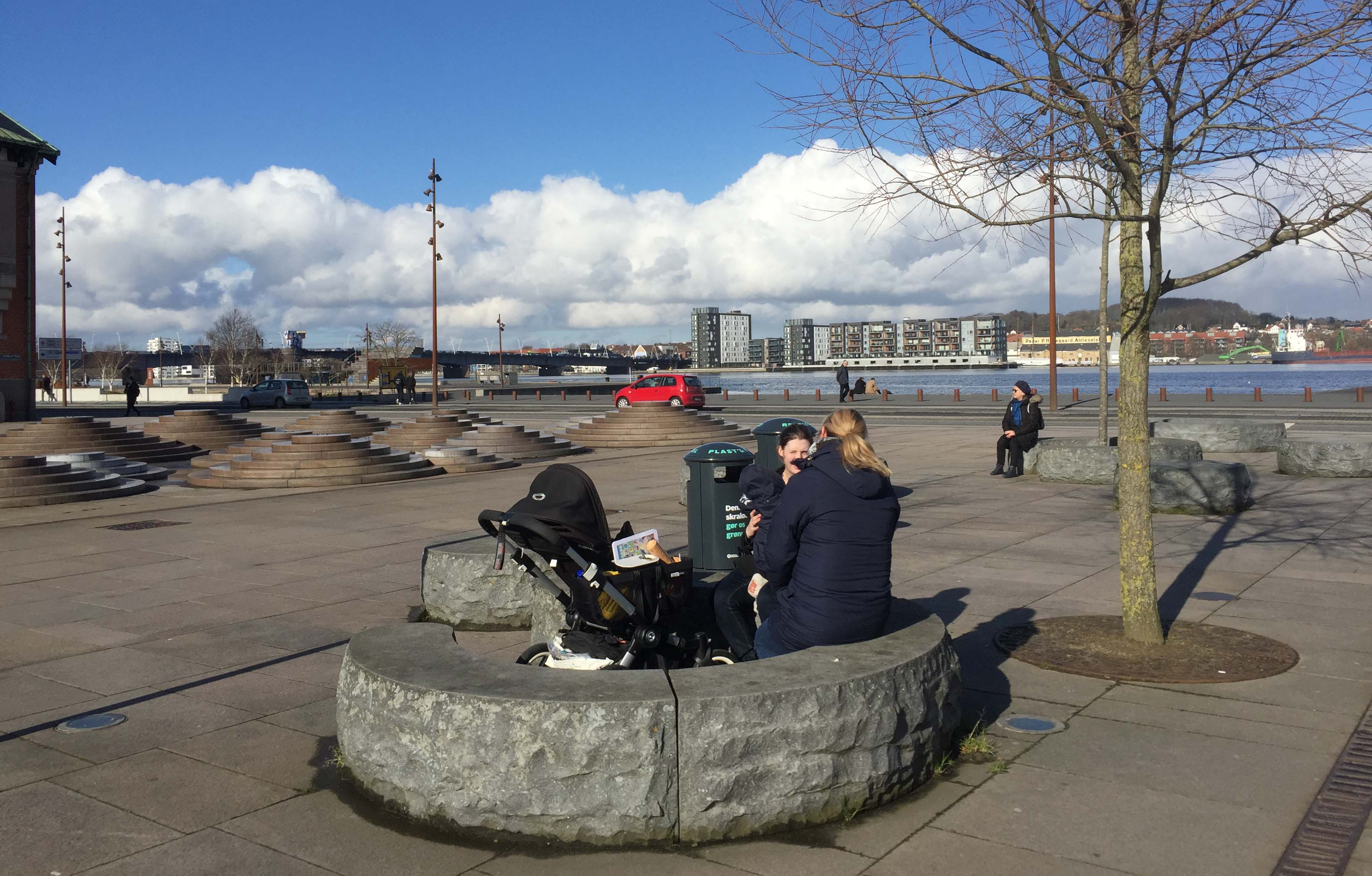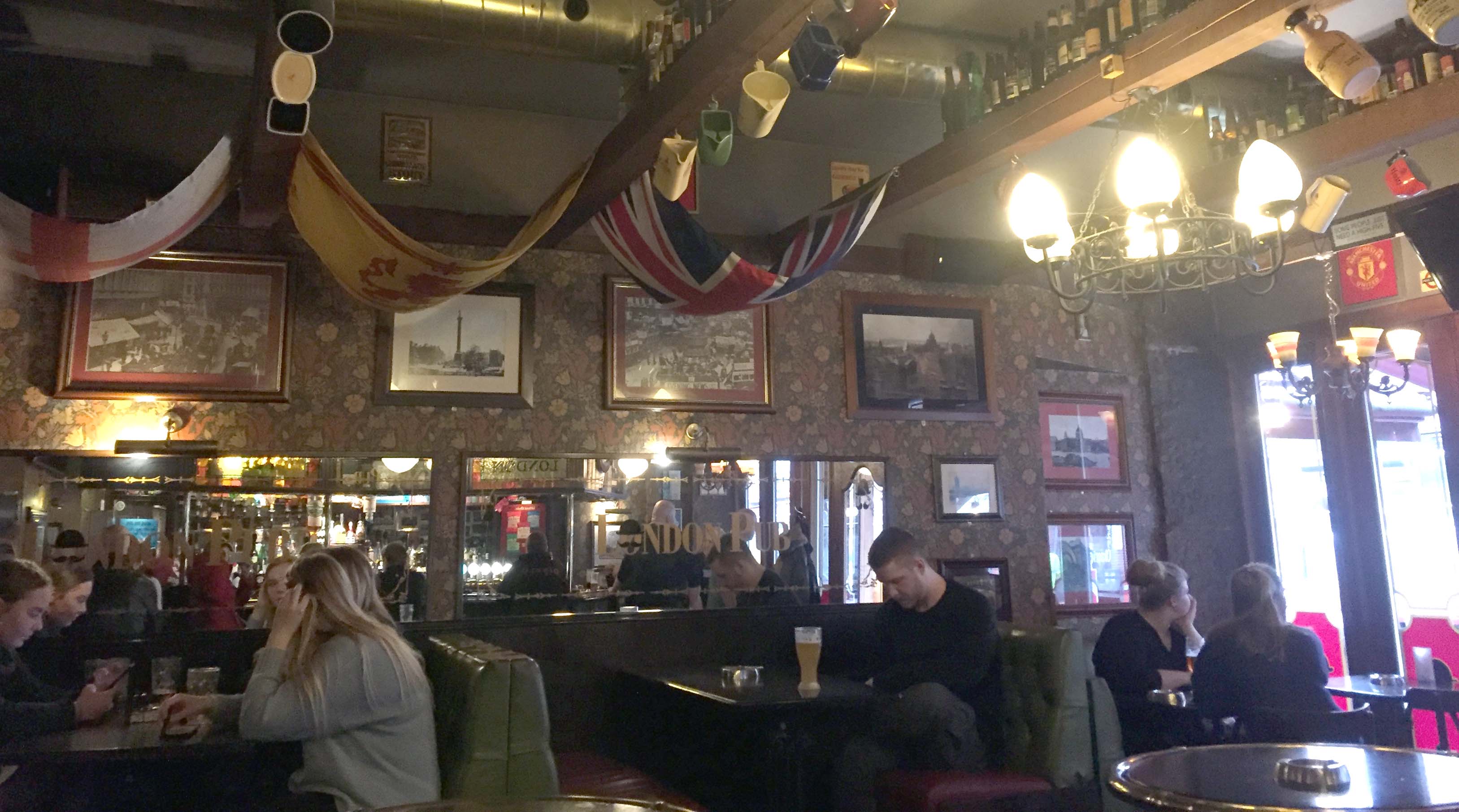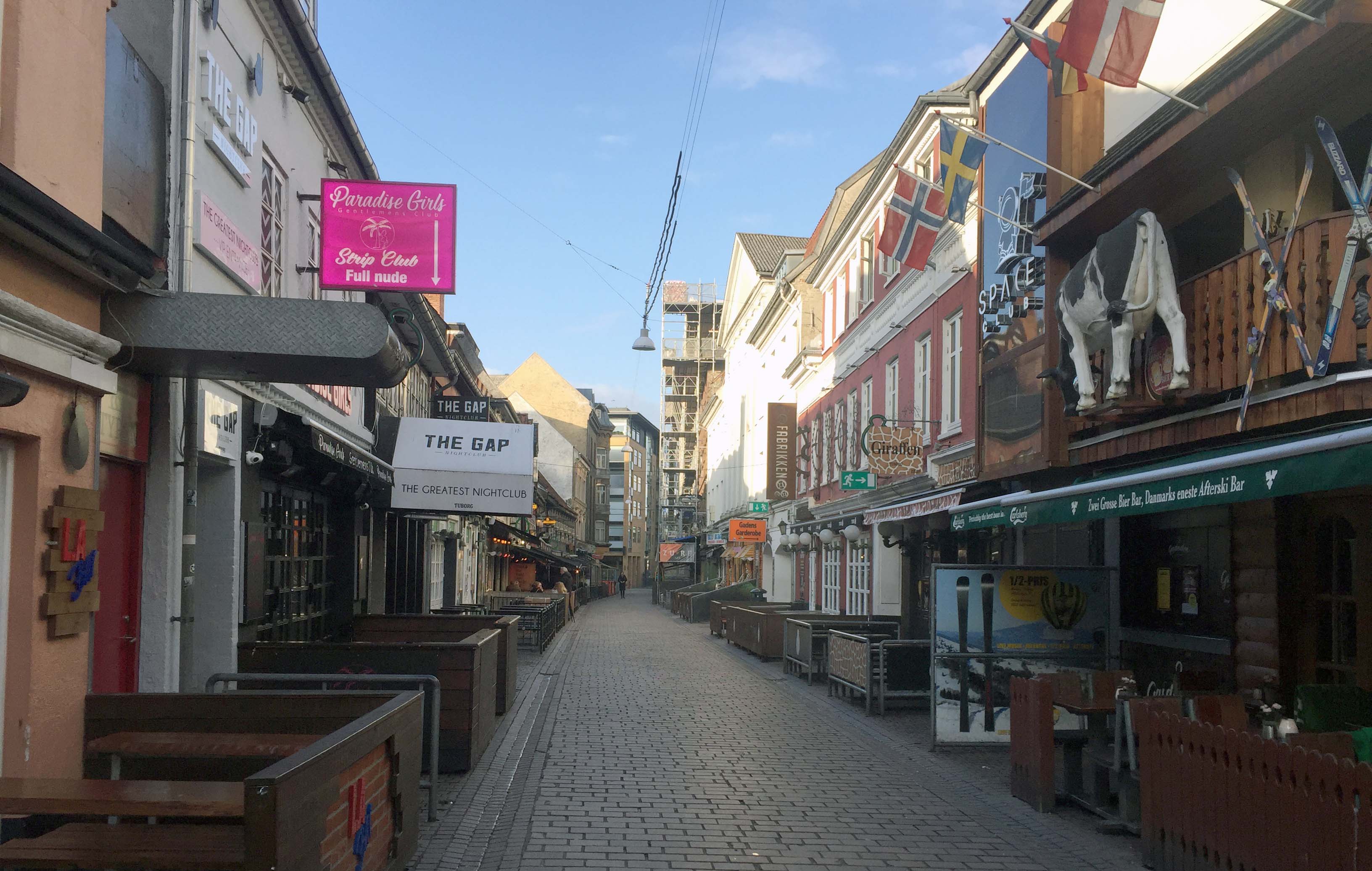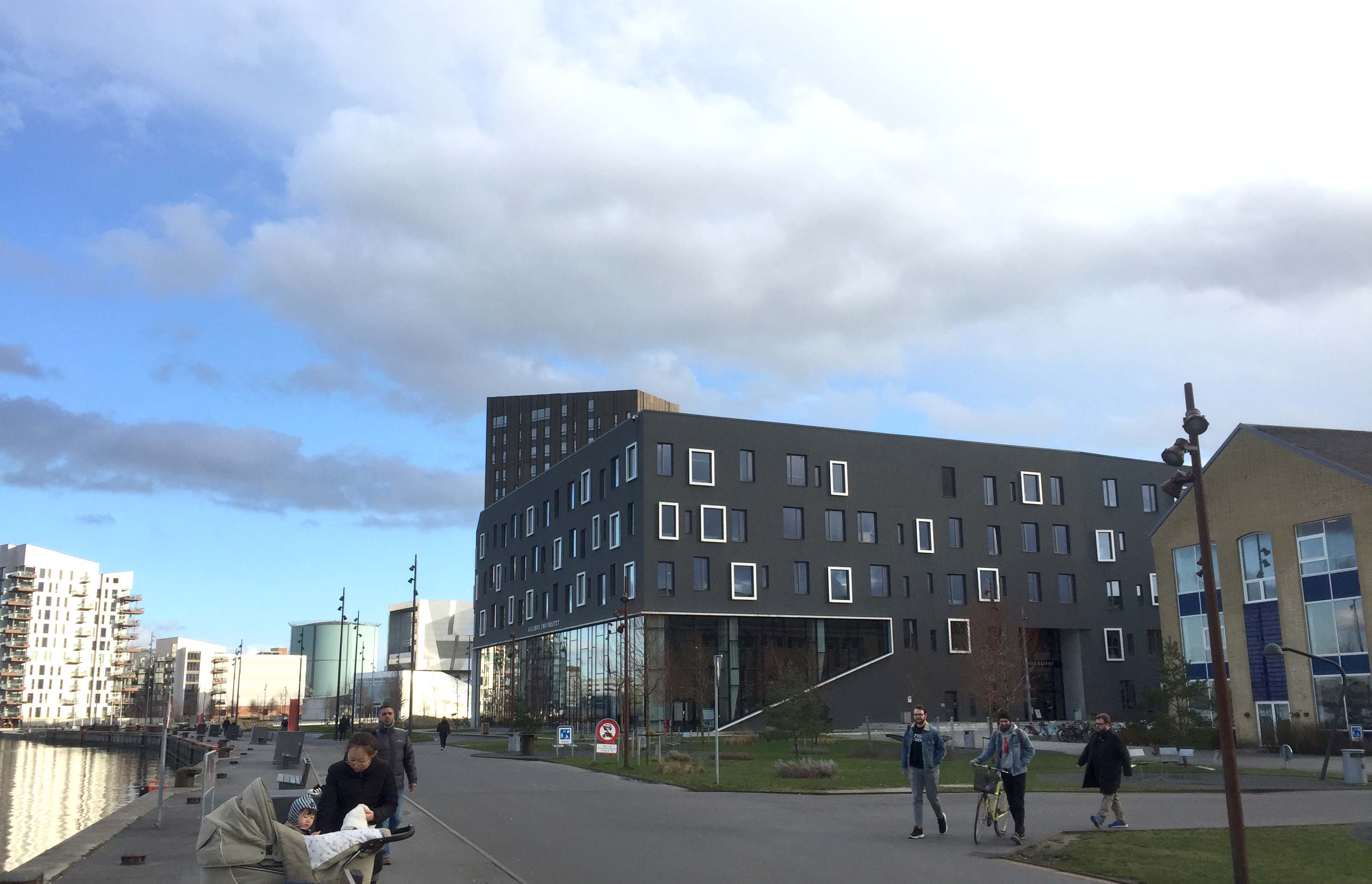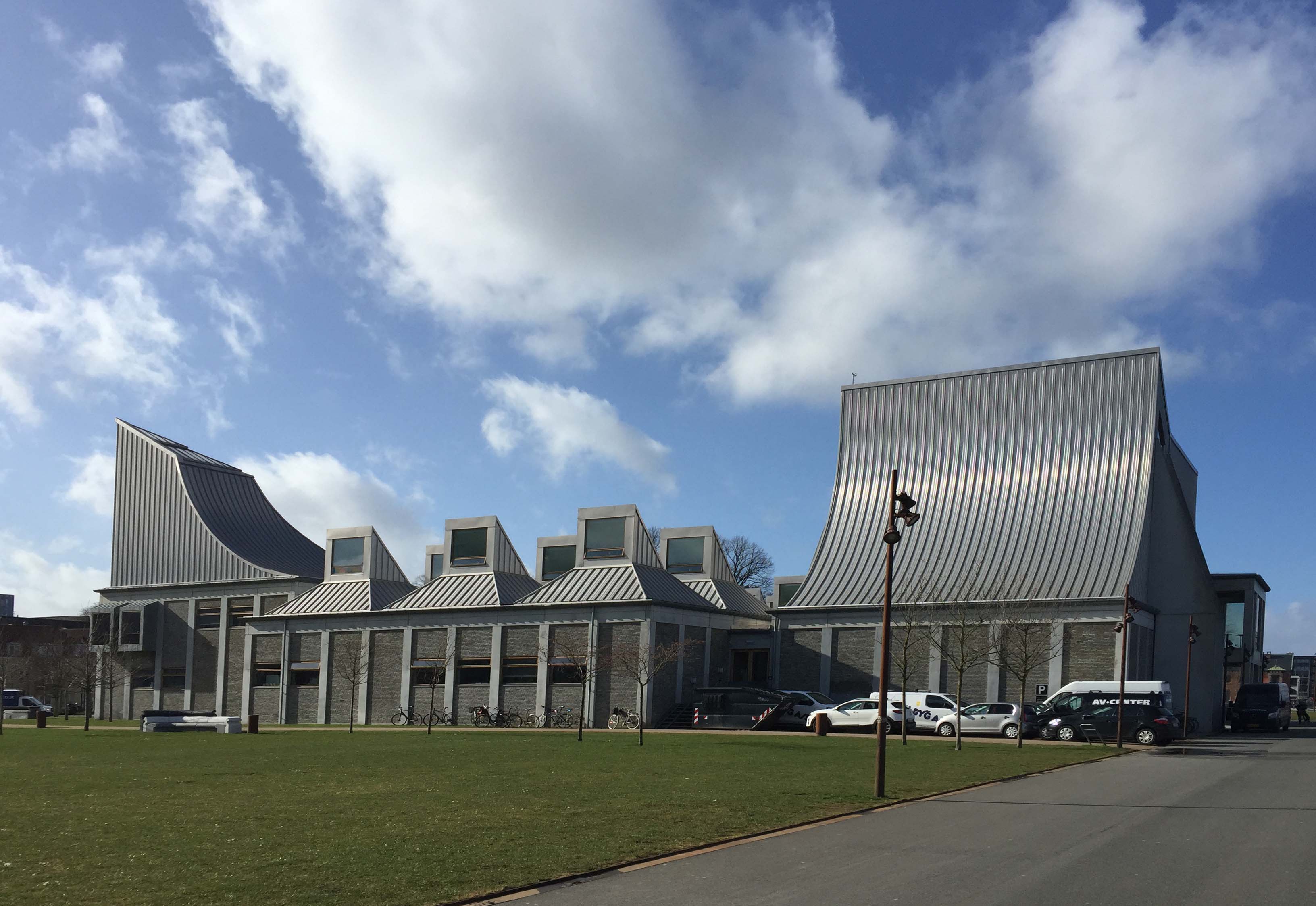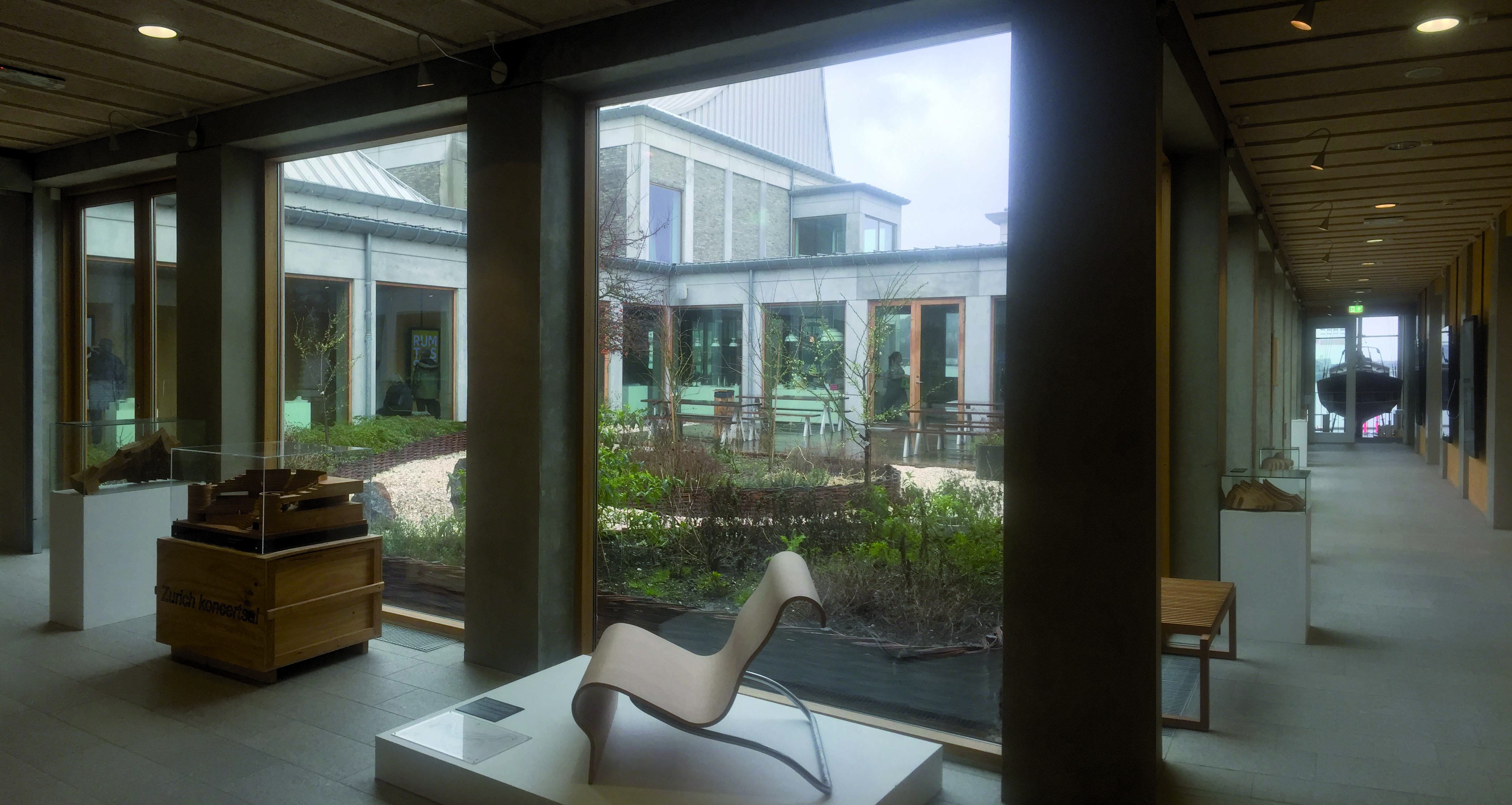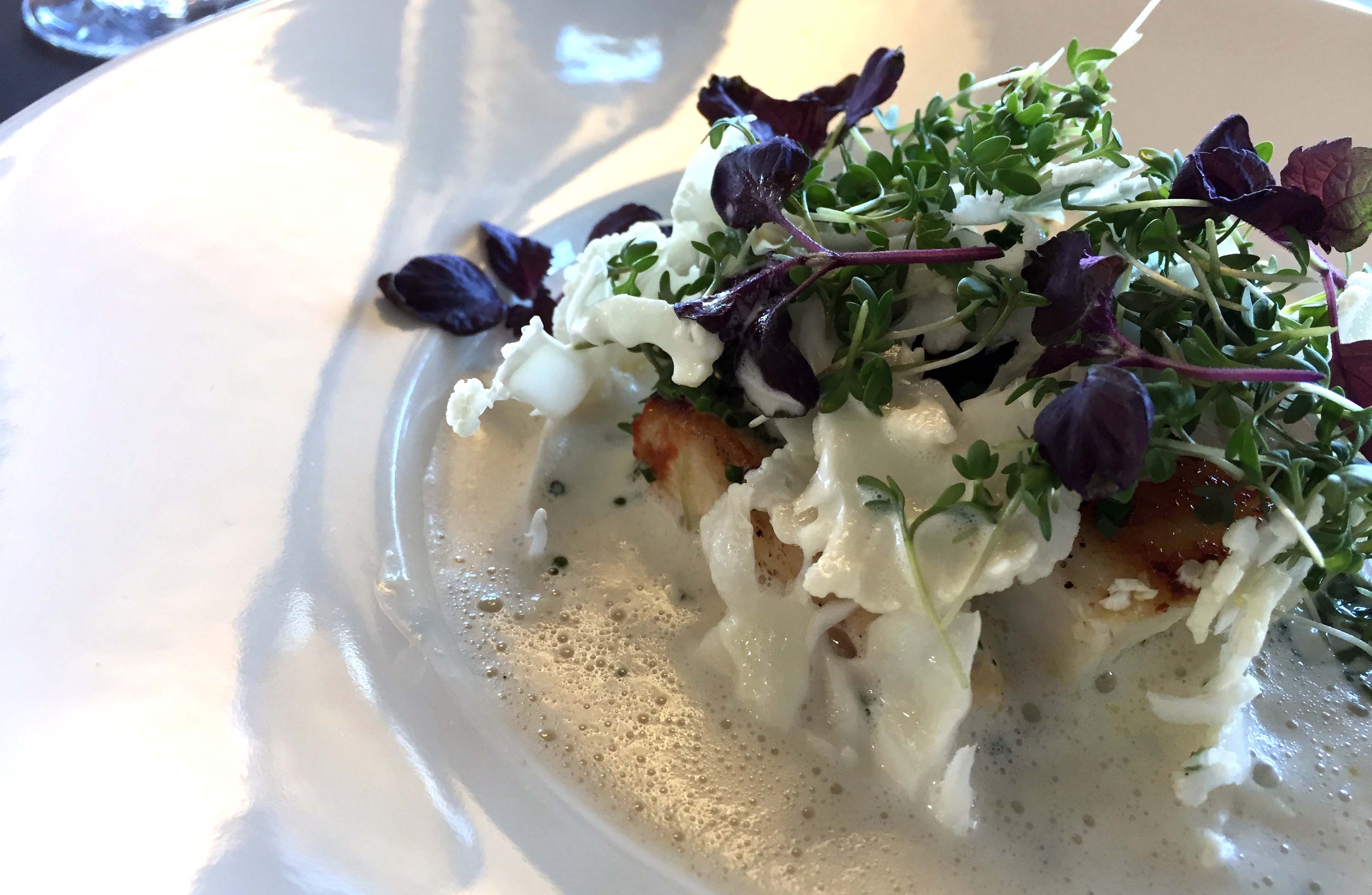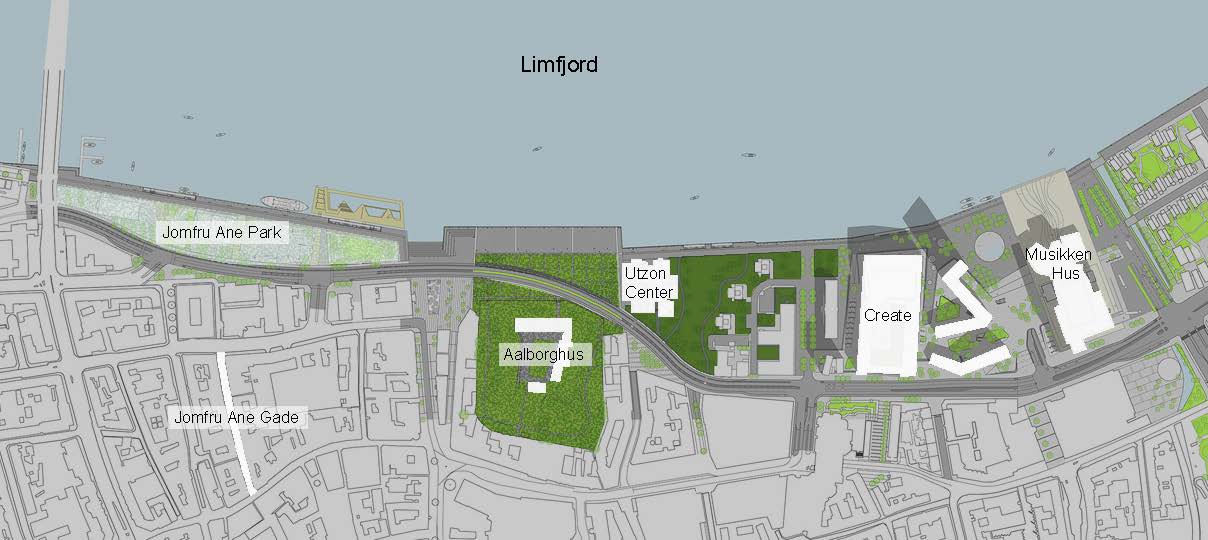The strongest and most appealing image of Aalborg is its waterfront, facing the Limfjord that runs across Denmark, halfway between Kattegat and the North Sea (following image).
However, until a few decades ago, this water-“front” could have been described more likely as a sequence of “rears” of inaccessible, degraded and disused factories and abandoned port infrastructures.
Fed by the strongest will power, the city council decided to adopt a new project in order to emerge from the economic crisis that, between the Seventies and Eighties, saw factories and industries shutting down one by one. The idea therefore was to reconvert the image of the city from an industrial and port center into a strategic, innovative and international hub for instruction, healthcare, renewable energies and digital technologies.
The formerly industrial buildings were reconverted, and sometimes completely replaced, with the aim to host research centers, cultural activities and services for the community, overturning the pre-existing bond with the waterfront, this time projecting their main façade towards the fiord.
Two groups of architects, C.F. Møller Landscape Architects and Vibeke Rønnow Landscape Architects, collaborated for the call for the waterfront revaluation. Between 2004 and 2013, the waterfront of Aalborg was completely renovated, turning into the new city center: along the pedestrian and cycle promenade long more than a kilometer, there is a sequence of gardens, picnic areas and cultural services designed to accomplish the needs of any age and social category, conceived to attract a new population of students, young families, researchers and businessmen. The success of this project convinced the city council to expand the area: the realization of new facilities and recovery of disused port areas are, indeed, currently ongoing.
Aalborg, the new waterfront facing the city center.
Admiring this superfast renewal of the city hitting its core, its economy and social components, we therefore wonder what is maintained, what has gone lost and what has changed in the gastronomic traditions of Aalborg.
Bars and pubs with excellent beer selection are always open in the historic center; some serve beer straight from the barrel, other are in fact real breweries. The atmosphere has retained its original features, offering customers the possibility to watch football matches, to read newspapers, to play table games or to have a tattoo done in the backyard (following image).
Aalborg, a pub in the Østerågade, one of the main streets of the historical center.
Along the Jomfru Ane Gade, the street famous for having the longest and uninterrupted sequence of bars, for more than fifty years dozens of restaurants, bars ad discos have opened and have been frequented by students and night lovers (following image).
Aalborg, Jomfru Ane Gade.
While Jomfru Ane Gade, also known as Gaden, retains its appeal and is considered one of the main attractions, one of the most famous icon of Aalborg has left the city: De Danske Spritfabrikker, the popular brandy distillery, closed the doors of the imposing factory overlooking the Limfjord in 2012, delocalizing the entire production in Norway.
The first factory of brandy that opened in Aalborg was Akvavit Aalborg Distillery, founded by Isidor Henius back in 1846; the very clever businessman was capable of producing the distillate on an industrial level starting from potatoes rather than cereals, thus exploiting this agricultural prime material easily available, way cheaper and less susceptible to the frequent storms and loss of harvest.
After extraction, the distillate is flavored with cumin, dill, Madera and aromatic herbs; flavors dictate the different varieties of brandy produced, such as Nordguld, aged in sherry cask and enriched in taste and chromatic shades of color by the fascinating treatment on amber stones.
Despite the brandy is not produced in the city any more, the Aalborg trade mark is still an excellence in the field of Akvavit with its distinctive notes of cumin and pepper, with a sweet backtaste of aniseeds, lemon, fennel and liquorice.
The closure of this and other factories triggered the need to reconfigure the waterfront, that has nowadays become the new city center; herein a sequence of museums, areas equipped for outdoor sport activities, universities and cultural institutes. In the requalified zones, there are new green picnic areas like the Jomfru Ane Park, the garden of the old castle of Aalborghus and the outdoor swimming pool floating in the Limfjord. Here you can admire astonishing examples of contemporary architecture such as the Musikkens Hus of the Coop Himmelblau, the Create campus complex with student residences designed by Henning Larsen Architects (following image) and the Utzon Center surrounded by sculptural benches (subsequent image).
Aalborg, the new university pole Create built on the waterfront. At the back, the Musikken Hus.
Aalborg, Utzon Center.
Among the new cultural buildings, the Utzon Center is the one that offers an exquisite immersive experience. The center was planned by the famous architect Jørn and his son Kim who wanted to donate to their native city a place where architecture meets society, where the nature-inspired design becomes a piece to exhibit in a museum, where spaces for laboratories welcome children and young people who try their hand at experimental activities, where offices and research laboratories are open to the free use of visitors (following image).
The architecture of the Utzon Center is perfectly integrated with the surrounding urban and sea landscape. The big windows facing both the inner cloister, with its garden, and the Limfjord erase the line existing between inner and outer space. The visitor is attracted by the exhibitions in the museum that are eager to tell stories of the father of the Sydney Opera House, revealing those poorly known details about his personality. The visitor that enters the Utzon center gets trapped by the numerous cultural initiatives promoted by the Center and, simply, is cherished by the Jørn Restaurant.
Oh Yes! That’s right: a restaurant nestled in a cultural center!
And that’s exactly where I wanted to walk you to, to discover how the city of Aalborg in the middle of its transformation has been able to create a groundbreaking mixture of culture, tradition and innovation.
The tiny and welcoming restaurant realized in the name of the architect, is located in the north branch of the building that with its big windows make us feel utterly embedded with the city landscape (image in the text opening).
Fondly seduced by the interiors designed by the architect, the menu proposes a selection of high rate dishes, distinguished by their elegance and perfection, totally in keeping with the surrounding style. An thoughtfully selected wine list is available to accompany your choice of food and the mise en place is a triumph of well-balanced chromatic contrasts and sophisticated combinations of flavors, conceived to stimulate the five senses and to excite your imagination, as if, as a matter of facts, you were standing in front of a work of art.
Aalborg, Utzon Center, exhibition rooms overlooking the internal garden.
The gastronomy is molded in the total respect for of the environment, through the use of local and fresh prime food and biological products; the classics of the Danish culinary culture, relying on what can be easily farmed and harvested during the short Danish summers – such as cauliflowers, roots, meat, fish, and the must-have rye bread – are reinterpreted with surprising remakes which end up producing works of art with a contemporary taste.
For example, the codfish served on a cauliflower terrine, an artful remake of the more traditional smørrebrød, the dish that represents the Danish cooking and that is made with buttered rye bread, fish or meat and vegetables to finish.
The more modern version of the classic recipe consists in the replacement of the slice of rye bread with a terrine of cauliflower fried golden brown on two sides with salted butter. Placed on top, the opalescent codfish fillet from the North Sea, gently steamed and rendered crunchy by a garnish of carpaccio of cauliflower crudités.
Fish and vegetables are rigorously prepared without addition of any salt, which is brilliantly compensated by a sapid broth of warm fish, made velvety by addition of milk cream, and poured on the dish when served at the table.
Crowning the dish, a green/violet garland of watercress and radish sprouts, characterized by spicy notes that alternate and enhance the crisp fragrance of freshly cut chives (following image).
Aalborg, Utzon Center, Jørn Restaurant.
A new alliance between tradition and innovation, culture and conviviality, man and environment is celebrated today in Aalborg, the city where the principles established in the Charter of European Cities & Towns Toward Sustainability, here signed in 1994, are actually honored at 360 degrees, tangibly spreading out its effects in new sustainable models of cohabitation with our planet.
And cooking makes no exception, in the respect for tradition, yet without giving up to innovation, a well-balanced relationship of respect for the environment that today ranks Denmark as the happiest country of Europe!
Aalborg, plan of the waterfront. The places described in the article are highlighted in white.
English translation of Ester Badami
Head image: The Jørn Restaurant, located inside the Utzon Center, Aalborg.
Lo stile di vita sostenibile di Aalborg
L’immagine più forte ed attraente di Aalborg è il suo waterfront, disteso sul Limfjord che attraversa la Danimarca, a metà strada tra il Kattegat e il Mare del Nord (immagine seguente).
Eppure questo stesso fronte a mare fino a pochi decenni fa non era affatto un fronte, quanto piuttosto il retroprospetto inaccessibile e degradato di fabbriche dismesse e infrastrutture portuali abbandonate.
Con una forza di volontà sorprendente l’amministrazione cittadina ha deciso di dotarsi di un nuovo progetto per uscire dalla crisi economica che tra gli anni ’70 e ’80 ha visto chiudere una dopo l’altra fabbriche e industrie, riconvertendo la propria immagine da centro portuale ed industriale a hub strategico e innovativo di livello internazionale nel settore dei servizi per l’istruzione, la salute, le energie rinnovabili e le tecnologie digitali.
Gli ex edifici industriali sono stati riconvertiti o sostituiti per ospitare centri di ricerca, attività culturali e servizi per la collettività, ribaltando il rapporto con il lungofiordo verso il quale adesso prospettano le loro facciate principali.
Ad ideare il piano per un uso alternativo del lungomare hanno concorso i due gruppi di progettisti della C.F. Møller Landscape Architects e della Vibeke Rønnow Landscape Architects. Tra il 2004 e il 2013 il waterfront di Aalborg è stato completamente rinnovato divenendo il nuovo centro della città: lungo una promenade ciclopedonale di più di un chilometro si susseguono giardini, aree attrezzate e servizi culturali destinati a rispondere alle esigenze di ogni età e categoria sociale, attraendo una nuova popolazione di studenti, giovani famiglie, ricercatori e nuovi imprenditori. Il successo dell’operazione ha convinto la municipalità ad ampliare l’area di progetto: sono attualmente in corso la realizzazione di nuovi servizi e il recupero di altre aree portuali dismesse.
Aalborg, il nuovo waterfront di fronte al centro storico.
In questo rapidissimo rinnovamento della città nella sua forma, nella sua economia e nella sua composizione sociale ci chiediamo cosa Aalborg abbia trattenuto, cosa sia andato perduto e cosa è stato trasformato delle sue tradizioni gastronomiche.
Sono sempre aperti nel centro storico bar e pub con eccellenti scelte di birra; alcuni servono birra direttamente dalle botti, altri sono dei veri e propri piccoli birrifici. L’atmosfera si è mantenuta sempre quella caratteristica, con la possibilità di vedere tutti insieme le partire di calcio, di sfogliare le riviste messe a disposizione, di giocare ai giochi da tavolo insieme a qualche avventore o di farsi fare un tatuaggio nel retrobottega (immagine seguente).
Aalborg, pub sulla Østerågade, una delle strade principali del centro storico.
Lungo la Jomfru Ane Gade, la via che vanta il primato della più lunga sequenza ininterrotta di locali, da più di cinquanta anni si aprono uno dopo l’altro decine di ristoranti, pub e discoteche frequentati da studenti e dal popolo della notte (immagine seguente).
Aalborg, Jomfru Ane Gade.
Mentre la Jomfru Ane Gade, detta comunemente Gaden, mantiene ancora il suo charme come una delle maggiori attrazioni, una delle più famose icone di Aalborg ha invece lasciato la città: De Danske Spritfabrikker, la famosa distilleria di acquavite, nel 2012 ha chiuso i battenti dell’imponente fabbrica affacciata sul Limfjord delocalizzando la produzione in Norvegia.
La prima industria di acquavite di Aalborg fu la Akvavit Aalborg Distillery, fondata da Isidor Henius nel lontano 1846; il geniale imprenditore riuscì a produrre a livello industriale il distillato utilizzando le patate al posto dei cereali, sfruttando così un prodotto agricolo maggiormente disponibile sul mercato, meno costoso e meno soggetto alla perdita del raccolto dovuta alle frequenti intemperie.
Una volta estratto, il distillato viene aromatizzato con cumino, aneto, Madera ed erbe aromatiche; in base agli aromi vengono prodotte diverse varietà di acquavite, tra cui la caratteristica Nordguld che viene maturata in botti di Sherry e utilizza pietre di ambra per arricchire la fascia aromatica e impreziosire le sfumature cromatiche.
Nonostante il distillato non sia più prodotto in città, il marchio Aalborg rappresenta tuttora l’eccellenza nel panorama delle Akvavit con le sue inconfondibili note di cumino e pepe e il suo retrogusto di anice, limone, finocchio e liquirizia.
Dalla chiusura di questa come di altre fabbriche è nata la necessità di rifunzionalizzare il waterfront, che oggi è divenuto il nuovo centro della città: qui si susseguono musei, aree attrezzate per lo sport all’aperto, sedi universitarie e istituti culturali. Nelle aree recuperate si aprono spazi verdi attrezzati come lo Jomfru Ane Park, i giardini del vecchio castello di Aalborghus e la piscina all’aperto che galleggia dentro il Limfjord; qui sorgono episodi straordinari di architettura contemporanea come la Musikkens Hus della Coop Himmelblau, il complesso della sede universitaria del Create con le residenze per studenti degli Henning Larsen Architects (immagine seguente), l’Utzon Center circondato dalle sue scultoree panchine (immagine successiva).
Aalborg, il nuovo centro universitario Create aperto sul waterfront. Sullo sfondo la Musikken Hus.
Aalborg, Utzon Center.
Tra i nuovi istituti culturali, l’Utzon Center è quello che regala un’esperienza particolarmente ampia e immersiva. Il centro è stato progettato dal celebre architetto Jørn insieme a suo figlio Kim per regalare alla loro città natale un luogo dove l’architettura incontra la società, dove il design ispirato alla natura prende corpo nelle esposizioni museali, dove spazi per laboratori accolgono bambini e ragazzi che si cimentano in attività sperimentali, dove gli uffici e i laboratori di ricerca sono aperti alla libera fruizione dei visitatori (immagine successiva).
L’architettura del centro si fonde con il paesaggio urbano e marino circostante: le ampie svetrature, sia verso il chiostro quadrato interno che ospita un giardino, sia verso l’esterno aperte sul Limfjord, annullano ogni confine tra spazio interno e spazio esterno. Il visitatore è attratto dalle esposizioni museali che narrano la storia dell’autore dell’Opera House di Sydney, svelandone anche particolari poco noti della sua personalità; è trattenuto dalle innumerevoli iniziative culturali promosse dal Centro; è deliziato dallo Jørn Restaurant.
Proprio così: un ristorante in un centro culturale!
Ed è esattamente qui che vi volevo portare, per scoprire come la Aalborg in piena trasformazione ha saputo creare un innovativo mix di cultura, tradizione e innovazione.
Il piccolo ed accogliente ristorante dedicato all’architetto è ospitato nell’ala nord della struttura le cui ampie finestre aperte sul Limfjord ci fanno sentire pienamente partecipi del paesaggio della città (immagine in apertura del testo).
Piacevolmente sedotti dagli arredi progettati dall’architetto, il menù offre una selezione di ricercatissime portate, la cui eleganza e perfezione è paragonabile al suo stile. Una selezionatissima cantina accompagna la scelta del vostro piatto, la cui mise en place è un trionfo di equilibrati contrasti cromatici e ricercati accostamenti di sapore che stimola i vostri sensi ed eccita la vostra fantasia al pari di un’opera d’arte.
Aalborg, Utzon Center, sale espositive che prospettano sul giardino interno.
La gastronomia è totalmente improntata al rispetto dell’ambiente attraverso l’utilizzo di materie prime locali freschissime e prodotti biologici; i grandi classici della tradizione culinaria danese, basata su ciò che può essere facilmente coltivato e raccolto durante le brevi estati del paese – come cavoli, ortaggi a radice, carne, pesce e l’immancabile pane di segale – sono reinterpretati con sorprendenti rivisitazioni che ne fanno dei capolavori del gusto contemporaneo.
Come ad esempio il merluzzo su terrina di cavolfiore, una magistrale rivisitazione dello smørrebrød, il piatto rappresentativo della cucina danese a base di pane di segale imburrato, pesce o carne e verdure.
La rivisitazione della ricetta vede la fetta di pane di segale in fondo al piatto sostituita da una fetta di terrina di cavolfiore, soffritta nel burro salato che la imbiondisce da entrambi i lati. Al di sopra l’opalescente filetto di merluzzo, pescato nel Mare del Nord e delicatamente cotto al vapore, viene reso croccante dalla commistione con un carpaccio di crudités di cavolfiore.
La rigorosa totale assenza di sale nel pesce e nel carpaccio è brillantemente compensata da un sapido fumetto di pesce caldo, vellutato alla crema di latte, versato sul piatto al momento del servizio.
Incorona il piatto una ghirlanda verde/viola di germogli di crescione e ravanello, le cui note piccanti si alternano e si esaltano mescolandosi alla fresca fragranza di steli sforbiciati di erba cipollina (immagine successiva).
Aalborg, Utzon Center, Jørn Restaurant.
Una nuova alleanza tra tradizione e innovazione, cultura e convivialità, uomo e ambiente si celebra oggi ad Aalborg, la città dove i principi della Carta per uno sviluppo durevole e sostenibile, qui siglati nel 1994, vengono onorati sotto tutti gli aspetti, dispiegando concretamente i loro effetti in nuovi modelli sostenibili di convivenza con il nostro pianeta.
E la cucina non fa eccezione, nel rispetto delle tradizioni ma senza mai rinunciare alle innovazioni, in un sempre equilibrato rapporto di rispetto per l’ambiente che oggi vede la Danimarca classificata come il paese più felice d’Europa!
Aalborg, planimetria del waterfront. In bianco sono evidenziati i luoghi descritti nell’articolo.
Head image: Jørn Restaurant, all’interno dello Utzon Center, Aalborg.
